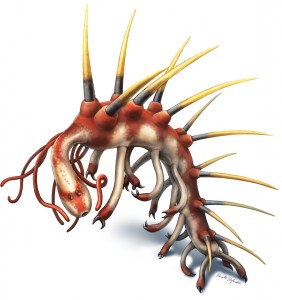
Hallucigenia sparsa is so bizarre looking that when scientists first reconstructed it they had it upside down and back-to-front. (Image credit: Danielle Dufault)
Newly discovered fossils from the Burgess Shale region are providing scientists with evidence of the evolutionary history of arthropods, a group including insects, spiders and crustaceans. The fossils have also allowed scientists to gather a complete picture of what Hallucigenia, an arthropod existing 508 millions years ago, looked like.
The new fossils show that Hallucigenia had a small but long head, at the end of a thin and long neck. The researchers were also able to determine that the animal had simple eye structures and circular teeth.
These fossils provide the first morphological evidence that arthropods belong in the superphylum Ecdysozoa.
Original research paper published in Nature on June 24, 2015.
Names and affiliations of selected authors

